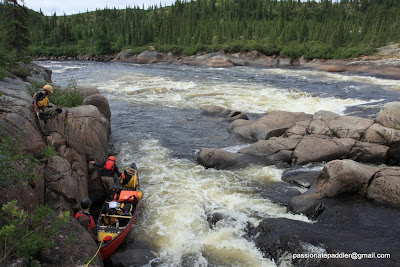
The fourth day marked the first time lining became an integral
part of the skill set needed to move down the river.
It was just the beginning.
The word lining is an abstract term to non-canoeist (and some canoeist) that read this blog, so I will have to digress a bit to get them up to speed. Lining is another option in a paddler's repertoire to move a canoe from point A to B. There are many reasons for this, but an obvious one is to avoid an unrunnable rapid. Portaging tends to be the option of choice, but if a trail is not available, it not only takes a long time to create one, but the carry can be burdensome. That's where lining comes in, - if its possible.
To line, you first attach ropes (30-50ft) at either end of the canoe. Then with both paddlers holding each end of the rope, you guide the canoe along the shore while bypassing the difficult section of the river. It takes skill and practice as both paddlers have to coordinate their movements to safely guide the boat through possibly strong currents, drops, shallows, and obstructions. But if you can read the water well and master how to manipulate the canoe from the end of a rope, it can make river travel much easier.
So why is this subject relevant? Because lining played an extremely crucial part in order to successfully navigate down the Romaine. See, this river's reputation for being very challenging stems from many reasons, the most obvious being the large number of unrunnable rapids. Due to this and the lack of people paddling this river, it also meant portages did not exist. Other times the shoreline topography (ie. canyons) did not afford foot purchase, and if they did, you'd have to deal with scrambling up huge erractics or hopping precariously on ultra smooth polished boulders. Even the rapids you could normally run are immediately followed by a rapid succession of unrunnable rapids/chutes/falls which meant there was no room for error. Put all these factors together and voila!, lining was our default method of travel! More to come!



1 comment:
Fantastic post! I had already kind of figured what lining was when I heard the term before, but the assumption that many (canoeists and non-canoeists alike) could benefit from a simple laymans explanation was quite reasonable. One read of your post and I feel pretty confident about trying it, as I will have to when I run the York River sometime this summer!
Post a Comment